A compilation of notetaking and studying tips Main Blog
Don't wanna be here? Send us removal request.
Text
how to do well in classes you don’t like ᕙ(`▿´)ᕗ
We all have classes that we don’t like, and usually we don’t do the best in them. Here are some ways I combatted that to make sure I did well.
Read the syllabus or marking scheme: imo, this is the best way to get acquainted with what you have to do for the class overall. It’s easier knowing how much you have to do to get a certain grade. Finding out the criteria for something makes it easier to handle those tasks especially for things you don’t like. Systemically handling such tasks makes sure that you don’t stress for that paper or project in the longer run.
Try to get interested or find something connected that you like to get more immersed in: I’ve said this before and I’ll say this again. Studying is boring but learning is fun. I had to take a required art class last year which really annoyed me, and the teacher wasn’t the best. But this was overruled over the fact that I really loved art and history. The world is full of interesting things; you can definitely find something you like in any subject you are learning, even math! This method serves as a motivator; for example, if you really like learning about black holes, studying for relativity in your physics class would help you understand more about them.
Always revise over what you are doing wrong: Another way to understand how to get the best grade in a class you don’t like is to look at how well you do on tests and grades. Most people don’t do well in these classes. You can look over what you have done wrong, and go back and see what the teacher is looking for in classes. Don’t overthink about how bad you did; instead, find what your teacher was looking for in your answer. This way, you know exactly how to answer next time. It’s another way to find out the criteria for how much effort you need to put in.
Ask for help: Another great way to do the best is ask help from someone you know is well-versed in a specific subject. If you really don’t understand what is going on in class, asking for help eases that stress. You’ll be surprised as to how well this method works.
Celebrate your successes: This is a great motivator. Finished that long paper? Take a break, watch a movie, have some fun. You’ve done a lot for something that has been causing you stress. You deserve it.
Consider dropping: If you really are feeling stressed, look for other options. Sometimes a class feeling like a burden has an immense impact on your grades. Think about how much this class is worth. Talk to your counselor. Are there other options? Other classes? Do you need to take this? It’s okay to drop something you don’t like if its really impacting your grades and your health.
I wish you guys all the best. It is really a big feat to do well in a class that you don’t like. Have fun and don’t take to much stress. Good luck!
355 notes
·
View notes
Text
Back to School Resource Masterpost
Hi everyone! It's that time of year again, back-to-school and all the excitement of learning new things, along with the stress and anxiety that inevitably occurs. I've been on Tumblr for longer than I'd like to admit, and have compiled a long list of resources below!
Please note that I did my absolute best to find the original links to all of these posts, but many of them are 4+ years old and the users have changed blog names/deleted. If any of the links don’t work, or there is a link to an original post which I am missing, please let me know! Many of the master posts have dead links so if you find any updated resources please feel free to add on :)
Starting College/New School Year
College Study Tips that Actually Help by @samsstudygram
How to Study in College by @niccistudies
Guide for Starting a New Semester by @studybeshy
No to Low Stress College Studying Strategy by @plannerdy
A Really F*cking Vulgar Guide to Not Losing your Sh*t in College (TW swearing) by @alice-rolfe
How to Be Successful in College by @goddesszillaa-blog
Studying for An Exam in A Really Short Amount of Time by @studiyng
Study Tips for the New Semester by @universi-tea
Back to School Masterpost by @studylau
Resources for the School Year by @ginsengstudy
Back to School Tips Masterpost by @starry-eyes-and-blissful-nights
Notetaking
Unconventional Note Taking Tips by @studyspiration-coffee
@emmastudies note taking system
Effective Notetaking by @afternaomi
Note Taking for Different Lecture Styles by @caffeinatedcraziness
Note Taking Tips by @eintsein
How to Take Notes from a Textbook by @staticsandstationery
Note Taking Tips by @parisgellerstudy
Essay Writing
Transition Words for Essays by @soniastudyblr
How to Write a University Level Essay by @healthyeyes
How to Write a Kick-ass Essay with Half the Stress by @wittacism-blog
Recovering an Unsaved Draft on Microsoft Word by @touched-dreams-blog
Helpful Websites for Writing Essays by @intellectys
Tips for Being Overwhelmed
How to Handle Having Too Much to Do by @howtomusicmajor
4 Tips for Getting Ahead after Falling Behind by @passwithclassandaniceass
Motivation Tips and Avoiding Procrastination
7 Strategies to Manage Distractions by @myhoneststudyblr
7 Strategies to Improve Concentration by @myhoneststudyblr
Tips to Stay Motivated by @maeve-studies AKA myself
6 Ways to Avoid Procrastination by @ivystudying
Tips for Motivation by @sobistudies
Getting your Shit Together by @coffeesforstudiers
School Prep and Motivation by @tea-study-sleep
Productivity
Guide to Crafting your Daily Schedule by @werelivingarts
Four Rules for a Disciplined Life by @a-disciplined-life (OG credit to reddit user ryans01)
How to Stay Productive by @busystudyin-g-blog
A Productivity Masterpost by @effortanderudition-blog
Planners, Apps, and Printables
Learn to Code by @boomeyer
Popular Apps Perfect for Students by @emmastudies
Printables Masterpost by @studywithnerdyglasses-blog
Listing of printables by @emmastudies
Study Apps and Extensions by @mujistudies
Apps for Students by @moleskinestudies-blog
Emails and Templates
Email Template for Anyone Who Struggles with Writing Emails by @ischemgeek
Post Interview Thank You Note Template by @a-windsor
Language Resources
Language Studying Tips by @ssehuns
Google Drive with a Link to Language Grammar Resources by @ingenjor-blog
Studying and Time Management Tips
@aimstudies on effectively reading textbooks
Tips on Managing Research Projects by @munirastudies
Memory Tips by @brain-exercise
Study Less, Study Smart by @marias-studyblr
Tiny Tips for Things You Never Thought About by @leahrning
18 Unexpected Tips for Higher Exam Scores by @studyblob
Study Tips from an MIT Student by @academicheaux
Self-Care and Burnout
@hellenhighwater on loving what you do, and doing what you love
Small Ways to Improve Your Life by @cwote
How I Ditched my Phone Addiction by @universi-tea
How to Avoid Overthinking by @onlinecounsellingcollege
Tips for Staying off Your Phone by @intellectys
Simplifying your Life by @universi-tea
For All the Bad Days by @studykouffee
How to Deal with Burnout by @kawaiistudy
Calming Masterpost by @shelbys-advice-blog
Ideas for Self Care by @educxtional
Masterposts
Masterpost of Everything pt 1 by @areistotle
School Cheat Sheet by @jwstudying
School Cheat Sheet part 2 by @jwstudying
Misc Studying Posts by @epicstudyings
Bullet Journal Ideas Masterpost by @optomstudies
Study Sounds by @universi-tea
Studyblr Masterpost by @getstudyblr
Study Methods by @etudiance
Study Skills by @schoollifeandstuff
4K notes
·
View notes
Photo
mochithings: Simplify your study habits with this chic, minimalistic planner. You can plan out your year, month, and week in detail so there’s no confusion at the end of the day!💡 The Weekly Plan section is laid out so one side is dedicated to planning while the other side has grid space for memos. Easy as un, deux, trois~ 😉 – Simple Journal Planner




Simplify your study habits with this chic, minimalistic planner. You can plan out your year, month, and week in detail so there’s no confusion at the end of the day!💡 The Weekly Plan section is laid out so one side is dedicated to planning while the other side has grid space for memos. Easy as un, deux, trois~ 😉
–
Simple Journal Planner
173 notes
·
View notes
Photo

1. Have a Positive Mental Attitude- Prime yourself at being always comfortable and confident that u can do a lot better at studying. Remember that you are studying things that will prove to be valuable in real life. 2. Prepare your Work Space- Look for a place in your home or bedroom where u think u can study and maintain concentration in your work. Have materials stocked up and in place before your study. This way, u can finish your work without any interruptions. 3. Avoid Cramming- study an hour a day even when there’s no homework. Scan your notebooks and do a little advanced reading of your textbooks. You can also research through the internet to learn more about the topics u are covering in school. I suggest google scholar, it’s like google but for students, it has the citations, and filters results so that only helpful outcomes appear. 4. Do projects with more enthusiasm and creativity- Don’t be afraid to think of new ideas or ways to present your homework or projects. Teachers always give additional points to students who show great effort in their works. SO, don’t be afraid to do something original, do something that hasn’t been done before. 5. Raise Your Hand- Be active and establish a friendly attitude towards your teachers. Offer to help them out in checking some work, filing papers or just carrying their things. Little good things add up in the end for that extra effort grade, and they’ll always remember you as a very helpful student. 6. Enjoy Reading the Latest News- Find connections or associations with your life as a student, as a child, as a friend, or as a citizen. Certain reports would always ask for u to react so better be ahead with current events which you may be affected with. 7. Listen to Your Teacher, take a few notes- In my experience, the more i copy and take down notes, the more i get lost in the lecture. It is best to listen first and understand before u jot down any important keywords. Yes, use keywords, simple doodles and arrows to make associations. These will help u remember all concepts mentally. 8. Keep Notes on Index Cards- I use personally use the smaller oxford ones, they are more portable honestly pretty aesthetic.. 9. Watch TV Wisely- Yep you heard it, TV, when watching TV I sometimes pick up points which may seem relevant in my life. They sometimes even have something to do with what’s happening in class at the moment so, always initiate conversation about the latest shows and issues you have watched. Don’t be afraid to argue and defend your opinions.
10K notes
·
View notes
Photo
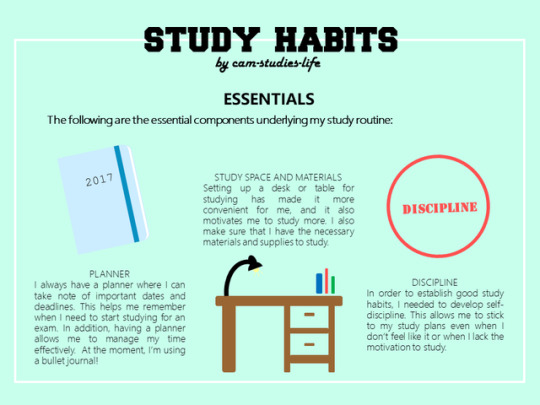
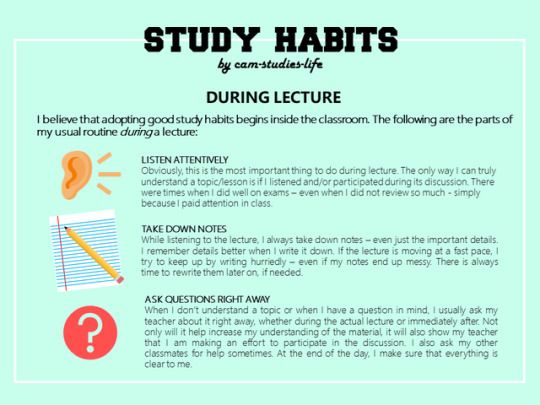
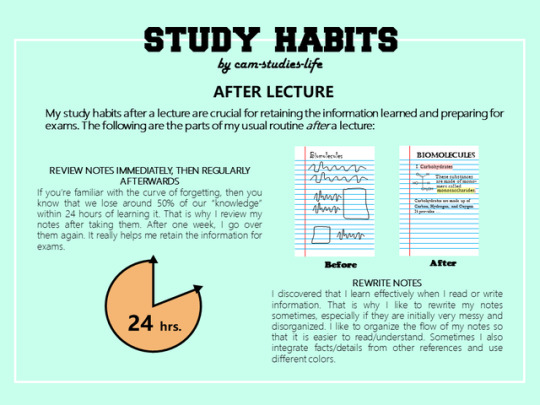
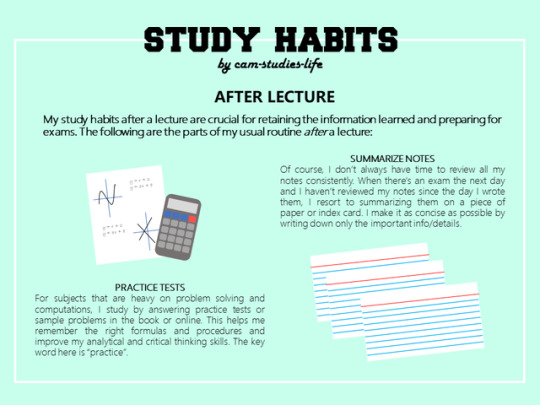
Sorry for my inactivity, I’ve been busy with college orientations and activities! Anyways, here’s a detailed infographic about my study habits, as requested by an anon. Please take note that these habits are effective for me, but may not be effective for you. Do not feel pressured to adapt these because there is no single “right” way to study! I encourage you to find out the best study habits for YOU.
9K notes
·
View notes
Text
10 types of planners
I’ve just discovered the Studyblr community. I’ve read lots of posts saying that you should use a planner, and since I LOVE planners, I thought that we should go a little bit deeper on this topic.
1. Bullet Journal
Bullet Journal is not a type of planner that you can buy, but a system to keep organized. First, you have to buy a notebook. Then, you’ll need to number all the pages and create an index. Finally, you’ll be able to create daily to-do lists using a complex bullet code.
Learn more about Bullet Journal.
Pros:
You can use the notebook that you prefer.
It is pretty meticulous and organized.
Cons:
Having to create an index, number all the pages… and basically creating a planner from scratch can be a waste of time.
Even though you have a monthly calendar, you can’t really asign tasks in advanced.
You can’t predict how long a to-do list will be so you will end up with blank pages and crammed tasks in other pages.
2. Chronodex
Chronodex is a graphic time managing system created by Patrick Ng. It consists on that circle diagram which works as a clock. You can print it out and stick it to any kind of notebook or planner and use it as a way to put up your daily tasks.
Learn more about Chronodex.
Pros:
It is better than a simple to-do list because you plan in advanced how much time you will spend doing each task.
It is visual and effective.
You can create a color code.
It can be used in an agenda or in a notebook.
Cons:
You have to print a lot of chronodex circles or make it a stamp.
You may also need to print out a calendar. Is that even a drawback?
3. Spiraldex
Spiraldex is a Chronodex sequel, created by Kent from Oz. It works exactly as Chronodex but using a different design, which, from my point of view, is a lot more clear.
Read more about Spiraldex.
4. Planner Pad
Each page works like a funnel: Top section for long lists (categorize tasks and activities), middle section for your daily activity plan (prioritize what need more attention from the top section) and lower section works like an appointment book (schedule).
Read more about Planner Pads.
Pros:
This system can actually be used in other kinds of planners.
One week per two-page spread.
Great for long-term tasks (helps you divide the work).
They can imprint your name in gold.
Elegant and formal.
Cons:
May be too sober.
5. Life Mapping System
DIYfish (its creator) says: “Life Mapping is a kind of color coding, time-managing, journal writing method that can help you record and organize your life without hustle.” It works pretty much like any other binder planner but with a twist on it. Every page has a color index on its margin that helps you search and locate important notes.
Read more about Life Mapping System.
Pros:
This system helps you to keep your notes organized in the long-term.
Cons:
You have to buy a binder and inserts.
6. Midori Traveler’s notebook
How to describe it? It is a piece of leather, with a elastic band around it to keep the journal closed and another one on the spine, so that you can attach refills. It is a traveler notebook… for people who… travel. But well, the journey from home to work and from work to home counts as traveling as well.
See more about Traverler’s notebooks / buy.
Pros:
Can add and change refills (so it is for life).
Not too big, not too small.
They promise that the paper is lightweight, thin and anti-transparency.
Elegant.
Cons:
About 50€ (worth it, in my opinion, because of the good quality).
7. Filofax
Filofax is the “original personal organiser” but there are more brands that sell this kind of binder planner, such us Gillio or Smythson.
Go to Filofax Official Website.
Pros:
It is for life.
You can add the inserts that are useful for you.
There are thousands of accesories for your filofax.
You can get creative.
Cons:
You have to buy inserts (that’s not necesary a disadvantage).
It can get really huge.
If you want to add your own inserts, you have to punch the holes by hand (because of the six holes).
8. Hobonichi
Hobonichi planners are mainly appealing to creative people since you have one page per day to record what you plan to do or what you have done. Every year, the design of Hobonichi is “refined and updated to reflect the demands of users”, as they say on ther website.
Read more about Hobonichi.
Pros:
Lay-flat binding.
There are A LOT of beautiful covers to choose.
You can get creative (and use watercolors!).
Includes one quote per two-page spread.
Their website seems extremely frank, reliable and neatly organized.
Cons:
The book costs 2,700 yen (about 20€ / $22) and you’ll probably want to buy a cover too (At least, 20€ more).
9. Personal Planner
Personal Planner is a website in which you can design your own planner (from the cover to the inlay design) and they send it to you.
Read more about Personal Planner.
Pros:
You can design pretty much everything.
Cons:
The cheaper agenda costs $29.95.
10. My planner system
I use a regular week-view planner. This is how I color code and stuff:
Daily homework: I (and probably the rest of the planet) write down my homework on the same day the teacher set it. I use a blue pen to write it and a red pen to cross it down when it is done. That way, done and undone work jump out at you. ➯ When I put something off: I cross it down with my blue pen and write it again on the day I plan to do it. That way I know that didn’t do it that first day but it doesn’t simply look undone. ➯ Long-term chores: (Such as essays or things that require a few days to be done.) I use the same method. For example: Today it’s Monday and the teacher says “You have to do a research paper about the Parthenon for next week”. I write on my planner (under Monday) “Parthenon essay”. When I get home, I decide that I’m going to do it between Wednesday and Friday, so I cross “Parthenon essay” with blue ink and write it again under the days that I plan to do it.
Exams: I write the exam on the actual day of the exam and then I highlight it so it is 100% visible when I get to a new page. Having a calendar on your wall with all the exams and deadlines is also essential. By the way, it is so relieving to cross off days on the calendar!
Deadlines: I write deadlines the same way I write exam dates. However, I highlight them using a different color so it is easy to tell them apart from exams.
Other: Such as details for an essay, what’s covered in an exam, etc. I use the note pages at the end of the planner.
6K notes
·
View notes
Text
IF YOU'RE A STUDYBLR
please reblog this post, I’m looking for new people to follow and more people to talk to😄
1K notes
·
View notes
Photo




Note-Taking
Hey guys! So I’ve been receiving questions regarding my note-taking style and strategy for quite some time now but I believe I have never answered them in detail. The good news is, I finally decided to make a post about this (plus, I had fun making the graphics :D). Note that I am a visual learner, so my note-taking methods may not be effective for some of you, but I hope you can all learn something.
Class Notes
I only use one notebook for all my class notes, an A4 grid notebook whose pages I divide into two columns.
I use the outline method for in-class notes, which means I write information chronologically, in the order that they are taught. Some teachers do not have properly structured presentations/lessons (good thing my physics teacher does) so when in need, I use arrows to connect related information.
Abbreviations to me are one of the most important things to master when taking notes. I personally make them up as I go along. Some examples of abbreviations I use are:
w/c - which
w/ - with
cpd - compound
envt - environment
digenz - digestive enzyme
It might be confusing, but to me, knowing the context and part of speech are enough for all abbreviations to be comprehended.
Here’s an example: ‘Indonesia’s tsunami pre-warning system is made up of two types of components’ could become ‘Indo’s snmi pre-warn sys 2 type comp’.
After Class
The first thing I would do is highlight keywords and terminology (and sometimes formulas). For physics, since my teacher is relatively succinct, I don’t really highlight, but for humanities and biology, I look for words that would be expected by a mark scheme, words that are crucial to the understanding of each particular piece of information.
I would then check if the material taught coincides with the syllabus, and if not, note down any points that are missing or have yet to be taught. You could write these on a post it or on the syllabus itself, but I prefer to highlight the syllabus’ pdf file.
Rewritten Notes
My rewritten notes are arranged based on the order they appear in the syllabus unless there are pieces of information that are related to more than one topic.
I use a black pen for rewriting notes as well as colored pens to write keywords and terminology only. I know some people who write whole sentences in colored pens but to me that is ineffective; we all have our own learning styles. When making tables, I usually use different colors for different columns (see the table for different types of radiation above) which is most often the color I associate with each word. For example, water would be blue, ocean would be a darker shade, ice would be a lighter shade, and water vapor would be purple.
I still abbreviate words in my rewritten notes, but they’re not as condensed as the ones in my class notes. Another thing I find helpful is leaving a bit of space between separate points especially if the page doesn’t have a lot of diagrams. I can’t think linearly, so I can’t remember super lengthy bullet points.
I use mildliners and a drawing pen to make my diagrams (more of these in my biology notes) but I only start with pencil if it’s a complex diagram. I rarely highlight my rewritten notes, but even if I do, it’s usually only the headings and formulas.
I don’t have a rough draft for my notes, but I try to visualize the layout. I try to alternate between words and pictures/diagrams so that when I’m sitting for an exam, all I have to do is imagine that I’m looking at that page and I can remember where everything is.
Well, that’s all from me. I hope that this information could be of some use to every single one of you. Don’t hesitate to ask me questions if you’re confused about note-taking or any other problems you might have :)
30K notes
·
View notes
Photo



I’m so in love with the muji 0.38 gel pen *^* I have been using it for everything lately xD
8K notes
·
View notes
Photo

i’m back with another masterpost!!! here’s a handy list of all the printables that have been made especially for 2017🎉
yearly overview by @emmastudies
yearly overview by @thearialligraphyproject
yearly overview by @arystudies
yearly overview by @apricot-studies
calendars by @thearialligraphyproject
calendars by @aescademic
calendars by @studylittlestar
calendars by @emmastudies
january monthly spread by @sundayscholar
february monthly spread by @sundayscholar
grade tracker by me!!
1K notes
·
View notes
Text
college note taking 101: how i take notes and use them to study for exams
in lecture:
i like to take quick/shorthand notes because i think learning to discriminate between what is and isn’t important material is a good skill to have so i’m not drowning in useless information when it’s time to study for a midterm or final.
i like to bring my ipad and use the notability app. it’s easier for me to just carry an ipad mini and stylus than it is for me to lug around a heavy notebook/binder and several pens/pencils.
if the professor makes lecture slides available to students online (via a class website), i like to download them onto notability and annotate them as the professor goes along. that way, i can focus more on what the professor is saying and less on merely writing everything down.
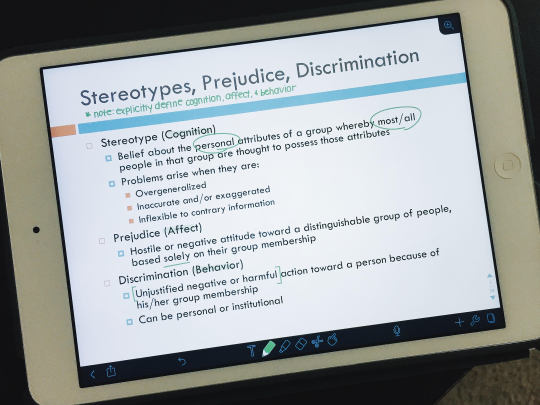
if lecture slides aren’t available, i type out my notes as i find it faster than handwriting them.
at home:
once i’m home, i take out my ipad and copy down my lecture notes into a specified notebook for that class, explain everything more thoroughly, make them neater, and organize them in a way that makes more sense to me (as opposed to copying them down exactly as how they were presented in lecture).
i like to use lots of colors, highlighters, and etc. and make them as pretty as possible so i actually want to use them to study from in the future.
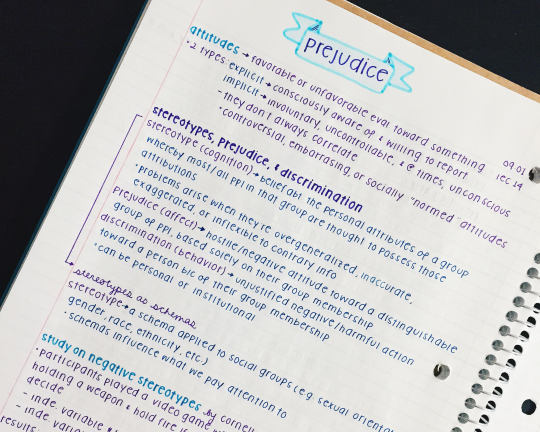
integrating reading notes:
normally, what professors will do is assign reading from a textbook and base their lectures around the reading (or have the reading be based on the lectures). usually exams/tests will rely mostly on what was said in lecture instead of in the reading and this is partly because they overlap so much. what the professor says in lecture, you should consider the “important points” in your reading. sometimes, though, there are things in the reading that seem important and weren’t mentioned in lecture.
what i’ll do if this is the case is take post-its, write the piece of information down, and stick the post-it in my notebook in the corresponding section (i.e. where it fits best with my notes)
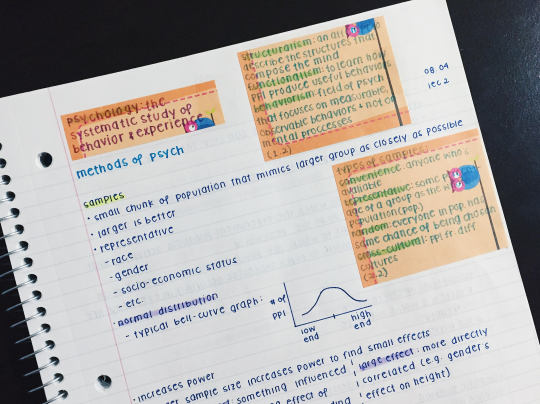
i like this method as opposed to taking notes directly in my textbook or having a separate notebook for only reading notes because 1) i’ve consistently found that reading material is not as heavily focused on in tests as lecture material and 2) i like to have all of my information in one place
using my notes to study:
when an exam is coming up, what i like to do is take all of the information in my notebook and condense it into a study guide that i can use to study from.
the format of my study guide varies depending on the class and which type of study guide and method of studying i think will help me best. my study guides range from flash cards to mind maps to sheets of paper with a bunch of condensed information.
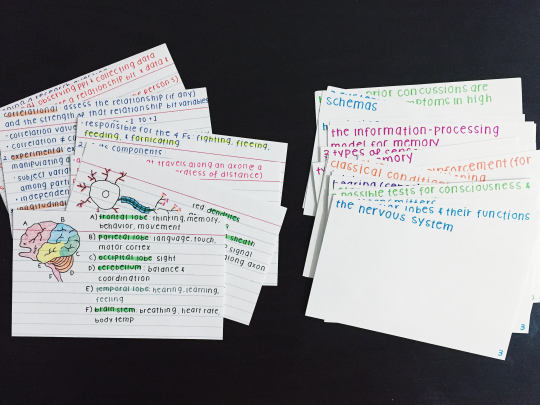
if i come across a concept on my study guide that i can’t completely explain to myself/don’t fully understand, that’s when i’ll look back in my notebook for a better and fuller explanation of it.
i also like to give myself some time before an exam to completely read through my notebook and look at all the notes i’ve taken (not just what i have on my study guide) because i think it’s a good refresher of all of the lecture and reading material and all of the information will be brought forward in my mind.
[* a few of you have asked me for a advice on note taking: how i take notes, methods i use, how i study from them, and etc. i hope this post was helpful to you! feel free to message me if you have any other questions. happy studying! ^_^]
35K notes
·
View notes
Text
My Study Method
My post 10 types of planners got way more notes than I expected. So today I will show you how I prepare for my exams. The method I’m going to explain is the one I’ve developed over the years and got me to get all A’s in high school. From taking notes, to nailing your exam.
1. HOW TO TAKE NOTES
1.1. Sit in the front of the classroom Don’t give a f**k if you look like a dork. Make sure you can see the blackboard clearly. You should be able to look at your teacher and the other way round. In case my experience is not enough: Studies show that those who “sit in the front and center (middle) of the classroom tend to achieve higher average exam scores”. Plus, your teacher will know who you are and will be aware that you pay attention in class.
1.2. Ask questions Don’t be afraid of asking questions. This took me years. Your teacher won’t think your question is stupid - in fact, it is their job to make sure everybody learns whatever they are supposed to teach. AND even if it looks as if the whole class has already understood the lesson, trust me, they haven’t.
1.3. Don’t write every word the teacher says There’s just no point in doing such thing. Contract words and use symbols and doodles. Once you get home, fair-copy your notes if they are not clear enough (or at least, re-read them). Otherwise, when you try to study with your notes a few weeks/months later, you won’t understand a thing.
1.4. Clarify your notes What did you just write down? Was it something that didn’t appear on the book? Was it an explaination of what the book says? Some info you should expand? Use a color code or symbols to clarify your notes. It doesn’t take time but will save you time in the future.
1.5. Compact notes Write with tiny (but legible) handwriting. It is quicker, tidier, and it saves paper. Also, write in two or three columns.
1.6. How to stay motivated to take good notes Last year I told one of my best friends (who is one grade bellow me) that I would give her all my notes at the end of the year. People normally dream of setting fire to their notes (and at least in Spain, people actually do that). But this other option (giving away my notes) was good for her and for me, since whenever I felt like writing carelessly, I’d think, “she won’t understand these notes, I have to do it better”.
2. PRE-STUDYING
Start pre-studying the very first day of class.
2.1. Active reading
Everytime I see someone whose book is entirely highlighted I’m like “why don’t you just dip it in a bucket of yellow paint?”. Seriously, stop.
Underline only the key words, not the whole sentence.
Use a different color (at least) for each paragraph.
When you read a paragraph, open a key in the margin and summarize what that paragraph is saying. Use between 1 and 10 words. Write as small as you can.
Right after you finish with a page, do an outline of the whole page in order to make sure that you have understood what you’ve just read. How? Scroll down.
2.2. Make it visual
Outlines, mindmaps, graphics… it really depends on the subject. All I know is that I just CAN’T study from a block of text.
Separate coordinated sentences and link them with symbols.
Use bullets or numbers and indent.
Color is not decorative. The same color links together different ideas.
Pink highlighters are cute but they don’t highlight at all.
Small handwriting and columns are your friends.
Highlight just the KEYWORDS. About 4-8 words per page.
Don’t use the same template or style on every page, unit or subject.
Number your pages.
Here you have a messy and a tidy example:


3. STUDYING
3.1. When should you start studying?
When I was in high school, I used to start studying one or two weeks before the exam. A few days before when I was too busy. The day before when I was about to jump out the window.
Divide whatever you have to study in equal parts to make it more approachable.
Try to organize yourself so that the day before the exam you don’t have to study because you already know everything (and you just need to revise a little bit).
3.2. Studying (and by studying, I mean memorizing) Once you have read it and understood it, you have to memorize it. My favourite quote is: “Don’t practice until you get it right. Practice until you can’t get it wrong.”
These are my methods. I also recommend reading this article for more. Use the method that works best for you or all of them to ensure you’ve got it.
Write your mind-map again and again and again. Don’t change the placement of each concept in your mind-map or you’ll become confused in the end.
Translate words into drawings. Translate your drawings into words. Repeat. Repeat!
Read a little bit, try to explain it out loud as if you were a teacher. Repeat endlessly.
Make a story that helps you fully understand what goes next and WHY.
3.3. Keywords list This is the spine of my whole studying method. So basically, reduce each sub-topic to ONE word. Then reduce each topic to ONE word. Study those words by heart.
In the exam, just write down your list of keywords and you will easily remember each topic and sub-topic.
4. EXTRA TIPS
4.1. When studying a list of words or names It is really important to know how many words there are.
Make a sentence with the first letter of each word.
Make a song. You can use a jingle you already know.
Picture a scene which contains all the words.
4.2. IMPORTANT!
Highlight, bookmark and make a list of those concepts that you usually forget or make mistakes, so it is the first thing you see (and revise) the next time you study.
The night before the exam, write in a little piece of paper that thing (an important formula, something that you always forget, your keywords list…) and that’s the only thing you should revise the following day.
Talk to older students and ask them for their old exams. Your exams will probably be different, but if the teacher is the same, they’ll be similar.
5. HOW TO NAIL AN EXAM
First of all, you should take a look to the Text Anxiety Booklet. It contains a lot of information for the ones who get really anxious.
5.1. Appearance matters My teachers always say that when they are correcting our exams, illegible handwriting really pisses them off. Since they are humans, that attitude towards your exam will be unconsciously reflected on your mark. On the other hand, when they get to a visually appealing exam, they are more compassionate. Conclussion: MAKE YOUR TEACHER’S WORK EASIER.
Use your best handwriting.
Write your name on every page (if you are asked to do so).
Leave margins.
Separate your paragraphs.
Indent when necessary.
Number your pages.
5.2. Don’t ever leave a question in blank Ever. Every little point adds up to you final mark, and a blank question means 0 points. If you write something and it is wrong, you simply made a mistake. But if you don’t answer, your teacher might think that you didn’t do it because you didn’t study. However, remember that your teacher is older and wiser than you, and will notice if you are trying to fool them.
In some tests, mistakes subtract points. In that case, you’d better leave the questions you don’t know in blank unless you like taking risks.
5.3. What if you go blank First of all, wait a minute and take a deep breath. This is not a waste of time because it will actually help you do better. Now, do the rest of the exam and come back later. Then, if you still can’t remember, try retracing not what you studied but what you were doing while you were studying. Maybe you were drinking tea, maybe your father came into your room or maybe you heard something on the street. And remember that you control your breathing, and your breathing controls your feelings.
5.4. An exam is not a race I guess some people believe they’ll receive a prize if they are the first one to hand in their exam. Those people have all of my disapproval. Use all the time your teacher gives you and always, I mean ALWAYS, revise your exam before handing in it. Revise. Your. Exam. Did you follow the instructions correctly? Did you answered all the questions? Are there spelling mistakes?
That’s it. I hope you found it helpful.
14K notes
·
View notes
Photo

11/21/2016 Finishing up the last of my midterms and presentations before Thanksgiving break.
39 notes
·
View notes
Photo

A compilation of chrome extensions and iOS + Android apps (some are paid and some are free) °☆.。.:*・°☆
| For your computer |
fliqlo
momentum
lanes
clarity
embark
minimal clock
infinity
currently
polar clock
caffeine
f.lux
be limitless
leoh
dream afar
| For your note taking |
evernote
onenote
simplenote
somnote
iNotes
notability
notes plus
google keep
quip
inkflow visual notebook
jot
good notes
noteshelf
| For your to-do lists |
wunderlist
moo.do
todoist
habitica
trello
any.do
priority matrix
do
glass planner
swipes
timetune
| For your planners + calendars |
myStudyLife
myHomework
sunrise calendar
google calendar
plan
sol calendar
| For your timing + focus |
tide
forest
pomotodo
flat tomato
pomello
pomodrone
clearfocus
tomato timer
30/30
focusnow
tasks and measures
self control
stayfocusd
timewarp
cold turkey
atimelogger
writer’s block
| For your presentations |
prezi
powerpoint
emaze
raw shorts
powtoon
| For your storage |
google drive
dropbox
| For your mindmaps + diagrams |
mindmeister
lucidchart
goconqr
gliffy
google drawings
| For your tests + flashcards |
goconqr
quizlet
flashcards+
anki
| For your writings |
zotero
grammarly
hemingway
| For your health |
fabulous
plant nanny
safetrek
sleep bot
sleep better
to bed
nike + running
waterlogged
period tracker
weight loss coach
health mapper
medisafe
| For your inner peace |
stop, breathe & think
headspace
pacifica
noisli
sleepio
infinite storm
relax melodies
calm
sam
thunderspace
mindshift
taomix
i am
pillow
binaural
55K notes
·
View notes
Photo




WAH ive just hit another follower milestone & my first day of school starts tomorrow! (○^▽^○) so may all of you accept these printables as a thanksgiving & a parting gift (well..maybe a semi hiatus gift) so heres a mini printable pack that contains the following! (*・∀-)☆
a habit tracker (that takes up only half of a us size bond paper btw)
a study schedule ( i didnt put lines since the columns were so smoll so feel free!)
and finally! hand lettered stickers by yours truly! (there are excess png forms i threw in last minute so i didnt get to put it in the pdf file sorry!)
TY FOR FOLLOWING ME printable pack by Nicole of CMPSBLS:
HABIT TRACKERS
A STUDY SCHEDULE
STICKERS (please read this!)
thank you all again!! i hope you all have a wonderful summer & to my fellow pinoy studyblrs! i hope you have a great sy! THANK U AGAIN!! and may you hAVE a wonderful day and that you find time to print these !!! dont forget to tag me with #cmpsbls! y(^ヮ^)y
CMPSBLS’ Printables Form / about my printables
9K notes
·
View notes
Text

OMFG I just typed this whole thing and then accidently deleted it. Lol. Well, here’s to starting over!
Hi! I wanted to do this because I understand how hard it can be to learn anything on your own, and hopefully I can help.
But first, a gif.

Originally posted by apamexico
i. starting
‣ Assess what type of learner you are. Do you memorize things easily, or does it take you more time? Do you prefer seeing things written out, or visually? Everyone doesn’t learn the same way, and that’s okay (that rhymed)!
» If you want a name to the type of learner you are, here’s a quiz (it also gives tips depending on what type of learner you are) !
‣ Try to semi-immerse yourself in the culture.
» What I mean by this is just to expose yourself to the culture. It’s easy to learn Spanish without learning any culture, but without it, you miss important things! Also, it’s cool to learn about another culture. But do this in a fun way!
✍ For example, listen to music & radio, watch TV & movies [or dramas/soap operas/novelas (YOU WILL NOT REGRET IT)], go to restaurants, ask friends
‣ Make a study schedule
» I have a hard time with this myself, because I am very ambitious. Remember to be realistic. If you have 3+ of homework each night, maybe you can’t study every day, and that is A-okay!
» how to make one: here, here, and a template
‣ Have a unique way to motivate yourself. I saw this in another master post and thought it was so great. It suggested you reward yourself when you study, for example, watching a favorite show afterwords or making yourself a smoothie.
And finally, breathe, you got this!
ii. the Alphabet
‣ Learn like a child with alphabet songs! These really help me. I like songs and visual things in general tbh…
» Songs in: Spanish, English, Korean, Japanese, French, ASL, Russian and more!
‣ Find fun ways to remember the sounds
» For example, in Korean the ㅎ makes an h sound, and a video I watched told me to remember it as a man with a hat on his head
‣ And always write down everything!
iii. the basics
I am constantly trying to rush the process. But, as my great piano coach says, “The process has to be as important as the product.” So before going to the fun stuff, I recommend knowing:
‣ colors
‣ numbers
» a number song in Korean, 6 other languages
‣ essential phrases : how to introduce yourself, how to say how old you are, how to ask for help, ‘thank you’, ‘please’, etc…
‣ days of the week
‣ how to say what time it is
‣ honorary terms
» this really depends on the language. I’m actively learning Spanish and Korean and in those two this is important.
✍ ex. It’d be kinda weird to call my two year old cousin ‘usted’.
iv. the fun stuff
And finalllyyyyyyy…. the fun stuff!!! Since you’re not learning this in a formal classroom setting, you can really do whatever you like.
‣ Grammar
» Start small: learn one bit of grammar every other day, or whenever feels best, and put it into practice
» Stick to one good source: I just say this because hopping around sources can be really confusing, and not every source teaches same way
» You don’t have to spend loads of money!! When I first wanted to learn a language, I thought Rosetta Stone would be my only option (lol). But there are so so so so so many options, ones that are free!!
All but BBC Languages are available as apps.
✍ Duolingo
✍ Mondly: like Duolingo, but more languages
✍ HelloTalk: Talk to native speakers! I’m doing it right now! I really love this.
✍ BBC Languages
‣ Vocabulary
» Pick 3 (or more) words to learn a day. My NemoSpanish and NemoKorean apps introduce me to 3 per day.
» Label things in your living space (if you’re allowed to)
» If you don’t know it, don’t ignore it, learn it!
» Find cool ways to remember words
» Write every word you learn down.
‣ Making it fun
the best part
» reward yourself; watch + listen to things; be patient, it’s okay to make mistakes; join/make study groups
Ok that’s all!!
I hope this was helpful! Please message me if you have something you think I should add. And thanks for reading!! <3
9K notes
·
View notes
